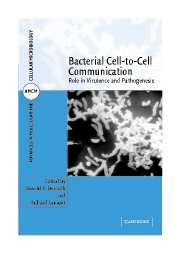Book contents
- Frontmatter
- Contents
- List of Contributors
- Preface
- 1 Quorum sensing and regulation of Pseudomonas aeruginosa infections
- 2 The Pseudomonas aeruginosa quinolone signal
- 3 Quorum-sensing-mediated regulation of plant–bacteria interactions and Agrobacterium tumefaciens virulence
- 4 Jamming bacterial communications: new strategies to combat bacterial infections and the development of biofilms
- 5 Quorum-sensing-mediated regulation of biofilm growth and virulence of Vibrio cholerae
- 6 LuxS in cellular metabolism and cell-to-cell signaling
- 7 LuxS-dependent regulation of Escherichia coli virulence
- 8 Quorum sensing and cell-to-cell communication in the dental biofilm
- 9 Quorum-sensing-dependent regulation of staphylococcal virulence and biofilm development
- 10 Cell-density-dependent regulation of streptococcal competence
- 11 Signaling by a cell-surface-associated signal during fruiting-body morphogenesis in Myxococcus xanthus
- Index
- Plate Section
- References
9 - Quorum-sensing-dependent regulation of staphylococcal virulence and biofilm development
Published online by Cambridge University Press: 08 August 2009
- Frontmatter
- Contents
- List of Contributors
- Preface
- 1 Quorum sensing and regulation of Pseudomonas aeruginosa infections
- 2 The Pseudomonas aeruginosa quinolone signal
- 3 Quorum-sensing-mediated regulation of plant–bacteria interactions and Agrobacterium tumefaciens virulence
- 4 Jamming bacterial communications: new strategies to combat bacterial infections and the development of biofilms
- 5 Quorum-sensing-mediated regulation of biofilm growth and virulence of Vibrio cholerae
- 6 LuxS in cellular metabolism and cell-to-cell signaling
- 7 LuxS-dependent regulation of Escherichia coli virulence
- 8 Quorum sensing and cell-to-cell communication in the dental biofilm
- 9 Quorum-sensing-dependent regulation of staphylococcal virulence and biofilm development
- 10 Cell-density-dependent regulation of streptococcal competence
- 11 Signaling by a cell-surface-associated signal during fruiting-body morphogenesis in Myxococcus xanthus
- Index
- Plate Section
- References
Summary
INTRODUCTION
Staphylococci are a genus of bacteria remarkably adept at causing a variety of human and animal diseases. These range from relatively benign skin infections, such as impetigo, to much more serious ones, including endocarditis, osteomyelitis, toxic shock syndrome, and those associated with implanted medical devices. In fact, the staphylococci are a leading cause of nosocomial infections worldwide, and the continuing emergence of highly drug-resistant strains has created an immediate need for the development of new antimicrobial therapies and strategies. Since the identification of the accessory gene regulator (Agr) quorum sensing system in Staphylococcus aureus, and subsequently in other staphylococcal species, it has been assigned a central role in the regulation of staphylococcal virulence. As such, it has attracted substantial attention as a potential target for controlling staphylococcal disease.
Although recent studies have shown that virulence-gene regulation by Agr is considerably more complex in vivo than initially understood from studies in vitro, it remains clear that expression of Agr, or even lack thereof, is an important determinant in staphylococcal disease development. agr mutants have been shown to be attenuated for virulence in some animal models of infection, including a murine arthritis model, an osteomyelitis model, and a skin abscess model (reviewed in (34)). It has also been shown that expression of Agr, and of Agr-regulated exotoxins, facilitates escape of S. aureus internalized by epithelial cells (49).
- Type
- Chapter
- Information
- Bacterial Cell-to-Cell CommunicationRole in Virulence and Pathogenesis, pp. 199 - 232Publisher: Cambridge University PressPrint publication year: 2006
References
- 1
- Cited by



